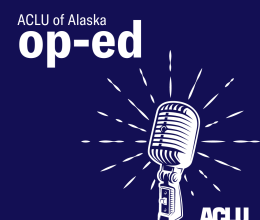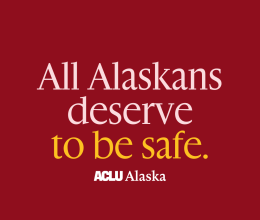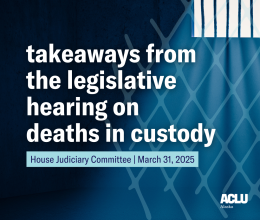
The American Civil Liberties Union and the Prison and Jail Innovation Lab at the University of Texas LBJ School of Public Affairs released Trapped in Time: The Silent Crisis of Elderly Incarceration, a report exposing how U.S. prisons are failing to keep up with the rising number of aging people behind bars.
Across the country, outdated sentencing laws have left tens of thousands of people imprisoned for decades, creating a humanitarian, fiscal, and operational crisis as correctional departments struggle to meet the medical, mental health, and accessibility needs of an aging prison population. Alaska's prison population has followed similar trends, posing ongoing issues for the Department of Corrections (DOC) and other agencies within the criminal legal system.
The report draws on data from public records requests to all 50 states to assess the challenges of managing a rapidly aging prison population. Key findings from the report include:
- The elderly prison population is exploding. In 1991, older people made up just 3 percent of the prison population. By 2021, that number had risen to 15 percent, or about 1 in 6 incarcerated people. If current trends continue, by 2030, as much as one-third of the U.S. prison population will be over 50.
- Prisons are not equipped to handle the medical and mental health needs of aging people. Older adults have far greater medical and mental health needs than their younger counterparts, but prisons consistently fail to provide adequate care. Many systems outsource health services to private providers that cut costs by delaying or denying treatment. Access to mental health care is extremely limited, and virtually no facilities are prepared to address dementia or cognitive decline.
- Elderly people experience distinct harms during incarceration that compromise their health and safety. Aging adults are forced to navigate facilities that were not built with them in mind. High bunks, inaccessible showers, and extreme temperatures due to lack of air conditioning can be challenging, if not life-threatening, to elderly people. When emergencies strike, from natural disasters to COVID outbreaks, prisons lack adequate emergency protocols, leaving older people at greatest risk of harm.
- Keeping elderly people in prison is costly and unsustainable. Housing an aging population in prison creates a significant and growing financial burden on state prison budgets. The data shows that medical costs for elderly incarcerated people have risen sharply across all states, with steep increases every year.
Specifically in Alaska, we know that inmates are aging. During the past decade, the number of people 55 and older incarcerated in the state has increased by 50 percent, according to data from DOC.
We also know that the standard of medical care for Alaska's aging prison population is inadequate, as outlined in a lawsuit filed by the ACLU of Alaska earlier this year challenging DOC’s dangerous and inhumane health care system.
Alaska’s spending on physical health care for prisoners increased 114 percent during the past 12 years, from about $31.5 million in 2012 to $67.4 million in 2024. According to DOC, for every day someone is housed in a state jail or prison, the cost of care is about $202 per day. However, this does not include medical care for chronic diseases, end-of-life, or emergency care. In a 2023 Anchorage Daily News article, Commissioner Winkelman stated, “The aging, fragile population drives our budget. It’s huge.”
The report also provides policymakers with evidence-based recommendations to reduce the elderly prison population and to limit the harm that aging people experience behind bars. Specifically, it recommends that lawmakers and elected officials:
- Expand opportunities for compassionate release by removing barriers that limit its use;
- Allow courts to revisit long sentences after 10 to 15 years, regardless of the original offense;
- Repeal or modify outdated extreme sentencing laws that created the current aging behind bars crisis;
- Address the complex reentry needs of elderly individuals released from prison;
- Better protect elderly individuals who remain in prison by ensuring they receive age-appropriate health care and by providing hospice services and dementia care; and
- Ensure that prisons comply with the Americans with Disabilities Act.
To combat the growing prison population of older adults, the State of Alaska has two types of parole, medical parole and geriatric parole, that it could use to reduce the elderly prison population.
Geriatric parole is for individuals who are 60 and older and have served at least 10 years of their sentence. Medical parole is for individuals who are diagnosed with a severe medical or cognitive disability after they are sentenced for a crime and, because of their condition, will not pose a threat of harm to the public if released on parole. The medical condition must also be unlikely to improve over the entire period of medical parole or likely to result in death. However, geriatric and medical parole are infrequently applied for or granted. In 2024, no Alaskans were granted geriatric or medical parole by the Alaska Board of Parole.
There is ongoing pressure for Alaska's correctional system to use the tools it has to ensure the incarcerated elderly are getting the necessary medical care that comes with aging, without draining the financial resources of the state and the corrections budget.
The full report is available here: https://www.aclu.org/publications/trapped-in-time-the-silent-crisis-of-elderly-incarceration

